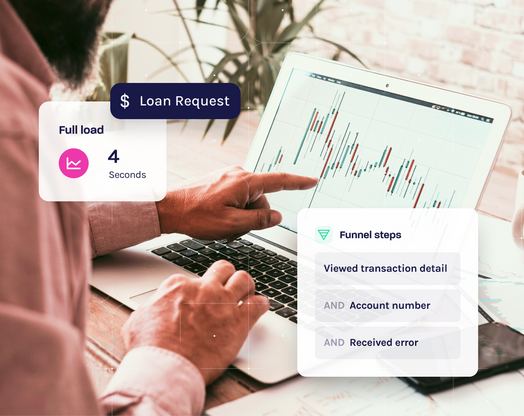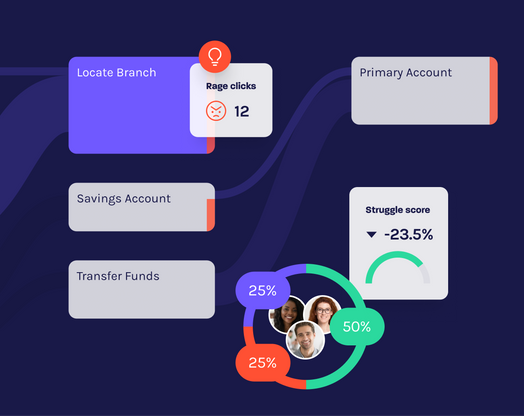
Why Product Research Drives Better Digital Experiences
In highly competitive business landscapes, how do you give your product the best possible chance of success? By building it strategically around market needs. In this blog, we’ll discuss how you can use product research to build winning products based on customer insights.
Key takeaways
Every new business is excited about its ideas—but that doesn’t mean customers will be. In fact, 42% of startups fail because their product doesn’t meet a market need.
However, there’s good news for companies who are willing to do the right groundwork when creating a new product or feature. By getting the right customer insights upfront, you can ensure you’re building something that meets user needs and fills a gap in the market.
That's where product research comes in. It’s about gathering data around user needs, experiences and market perceptions, so you can make informed decisions about your product.
In this blog, you’ll learn about:
Why research is important for product teams
What you can learn with product research
When the best time is to carry out product research
Which teams should get involved with product research
How to do product research effectively
Let’s dive in!
What is product research?
Product research means gathering information that you can use to make better decisions when building new products and features. This could include:
Researching user needs to discover how the product’s features could be adapted to deliver better experiences.
Analyzing the market to understand what competing products and features are out there, how customers perceive them and where the market opportunities are.
Investigating user experiences in an existing product or prototype to learn where users are having a less-than-optimal journey.
Why is research important for product teams?
In an increasingly competitive digital world, businesses want to build products and features that enhance the lives of their users. Product research helps them put users at the heart of their decision-making processes in several ways:
Identify customer needs and pain points. By conducting research, product teams can gain a better understanding of their customer's needs and pain points.
Validate assumptions and ideas. Product teams often have assumptions and ideas about what will work best for their target audience.
However, these assumptions aren’t always accurate. Through research, product teams can validate their assumptions and ensure that they are building products that will actually resonate with their customers.
Reduce the risk of failure. Building a product or feature without research is a bit like sailing into uncharted waters without a compass or map. Product research helps you get feedback from customers about what is and isn’t working, so you can correct your course if necessary.
Stay ahead of the competition. Product research can also help teams stay ahead of the competition. By gaining insights into evolving customer needs and behaviors, product teams can identify gaps in the market and develop products that will fill those gaps before their competitors do.
What can you learn from product research?
Product research is vital both for building new products and features and optimizing existing ones. The insights you’ll discover help in several ways:
Uncover unmet needs. Most people have challenges that they need help with—or frustrations with existing solutions. Product research can help you identify opportunities to solve them with products and features.
Gain a better understanding of customer behavior. In addition to understanding customer needs, product research also helps you gain valuable insights into how customers use and interact with existing products and features.
For instance, you can learn which features are most popular, which ones are underutilized and identify any roadblocks users may be encountering.
If your product already has a significant audience, A/B testing can help you discover how user preferences affect clicks and conversions.
Measure product success. Product research can also help teams measure the success of their existing products and features. By studying user data and feedback, they can identify areas where the product and features are performing well and where improvements are needed.
Prioritize future changes. Research can help you identify which user needs and desires are the most pressing, and how your competitors are responding. These insights can help you prioritize your product backlog and decide which changes would deliver the most value to your users.
When is the best time to carry out product research?
As a rule of thumb, it makes sense to carry out product research early in the product development process. By getting a good understanding of customer needs and current market offerings, you can design products that will be appealing to your target audiences.
What’s more, conducting usability testing and focus group research can help you identify potential hurdles, bottlenecks, and opportunities for improvement. By identifying these issues before investing significant time and resources into product development, your business can avoid costly mistakes.
Continuing product research after launch
Product research can also help you during other stages of the product life cycle. For example, if a product or feature is already on the market, conducting research can help you identify areas for improvement and opportunities to expand the product's features or target audience.
In some cases, it makes sense to conduct product research on an ongoing basis using post-launch surveys and user analytics. This can help your teams stay updated with changing market trends and ensure that your product remains relevant and competitive.
Which teams should get involved with product research?
Product research often requires input from multiple departments to be effective. Some of the teams that can contribute to product research include:
Product management. Product managers are responsible for the overall strategy and roadmap of the product. They typically conduct research to uncover what user needs are, what improvements would meet them and whether the changes are technically achievable.
User experience (UX) design. UX designers are responsible for creating the interface of the product and making sure that the product and featuers are easy to use. This often involves using usability testing to identify potential areas for improvement.
Marketing. Marketing teams typically research customer needs, the competitive landscape and industry trends. Their insights can help the company discover what product or features would be most appealing to key audiences, and what marketing strategies would make the most impact.
Customer support. Customer support teams interact with customers on a daily basis and are often the first to hear about issues and problems with the product. They can provide valuable feedback and insights into the needs and pain points of customers, which can be used to inform product or feature improvements.
Sales. Sales teams habitually talk with customers about what they’re looking for in a product. These insights can help you determine how to improve an existing product or feature in line with customer needs and decision-making processes.
Data analytics. Data analysts collect and interpret data around how users currently interact with the product. For example, product data can show which features are most popular with different user segments. By identifying trends in the data, analysts can uncover new insights into user needs and preferences.
How to carry out product research in 7 steps
While every product research project is different, the following steps will give you a framework to plan and conduct your research:
1. Define your research goals
First and foremost, identify what you want to achieve through the research. Be sure to set clear research goals and objectives whiles defining the scope and methodology of your research.
2. Identify your target audience
After you've established your goals, identify the target audience for your research. This step can include defining the characteristics of your target users and developing personas to represent them.
Developing personas will also help you recruit participants who are representative of your target audiences for interviews, focus groups and usability testing.
3. Choose your research methods
Most product research typically involves a blend of surveys, interviews, focus groups and user testing or usability testing. The most appropriate will depend on your research goals and the questions you want to answer.
Product teams may also want to carry out desk research on the market by analyzing social media conversations, following consumer trend publications like Trend Hunter and reading conversations in niche forums on Reddit.
4. Conduct your research
With your research goals, target audience and methods in place, you can start conducting your research. This may involve recruiting participants, preparing research materials and carrying out the research itself.
When you’re conducting research via multiple methods, use a repeatable methodology for each test to avoid bias. In addition, use digital tools that make it easy to collate and analyze your data later on.
For example, if you’re carrying out usability testing to find out what target audiences think of a competitor’s product, session replay tools can help you review individual user journeys later.

5. Analyze your findings
Once you've collected the data, you need to interpret it to identify trends. Review your data, identify patterns and themes and draw conclusions based on your findings.
Your analysis should tie back to the initial goals of your research, answering key questions about how your product can meet user needs or fill a gap in the market.
6. Put your research insights into action
You can now use your research insights to inform your product development process. Share your key findings with colleagues, along with recommendations for how your insights could shape the product.
Where relevant, share links to research data so you can more easily get buy-in on your recommendations.
7. Measure and evaluate success
Finally, establish KPIs to measure the success of your product research. Some examples could include customer satisfaction scores, website traffic, Net Promoter Score (NPS) or essential product metrics.
Regularly track these KPIs to make sure that you’re meeting customer needs while supporting your overall business strategy.

Unlock user insights to build better products with Glassbox
When you want to build a product that customers love, getting the right insights is crucial. By gathering a range of accurate qualitative and quantitative data by both observing and talking to customers, you can discover what they need most.
Glassbox helps you get a complete picture of your users by capturing 100% of user actions during every session. That means you can run deep analyses on your product data to learn what users are doing—then use advanced insights from Glassbox’s digital experience intelligence platform to understand why users behave the way they do. Learn more about Glassbox and get a demo today!
Product research FAQs
1. What is product research?
Product research is a data-gathering process that helps businesses make decisions about current or future products and features. By analyzing user experiences, industry trends and other products in the marketplace, businesses can create products and features that will serve users and outdo the competition.
Product research often involves a range of investigative methods such as focus groups, surveys, interviews and usability testing.
2. What tools should you use for product research?
When conducting user research, the right tools will enable you to collect, organize and analyze your data effectively. For example:
Voice of customer tools allow you to survey current and prospective customers on your website.
Interview tools help you record, transcribe and annotate user interviews.
Session replay tools can help you capture and analyze user journeys during usability testing.
Product analytics tools can help you analyze user engagement with an existing product to help identify user needs and preferences.
Social listening tools can help you analyze social media conversations to identify audience and product trends in your market.







